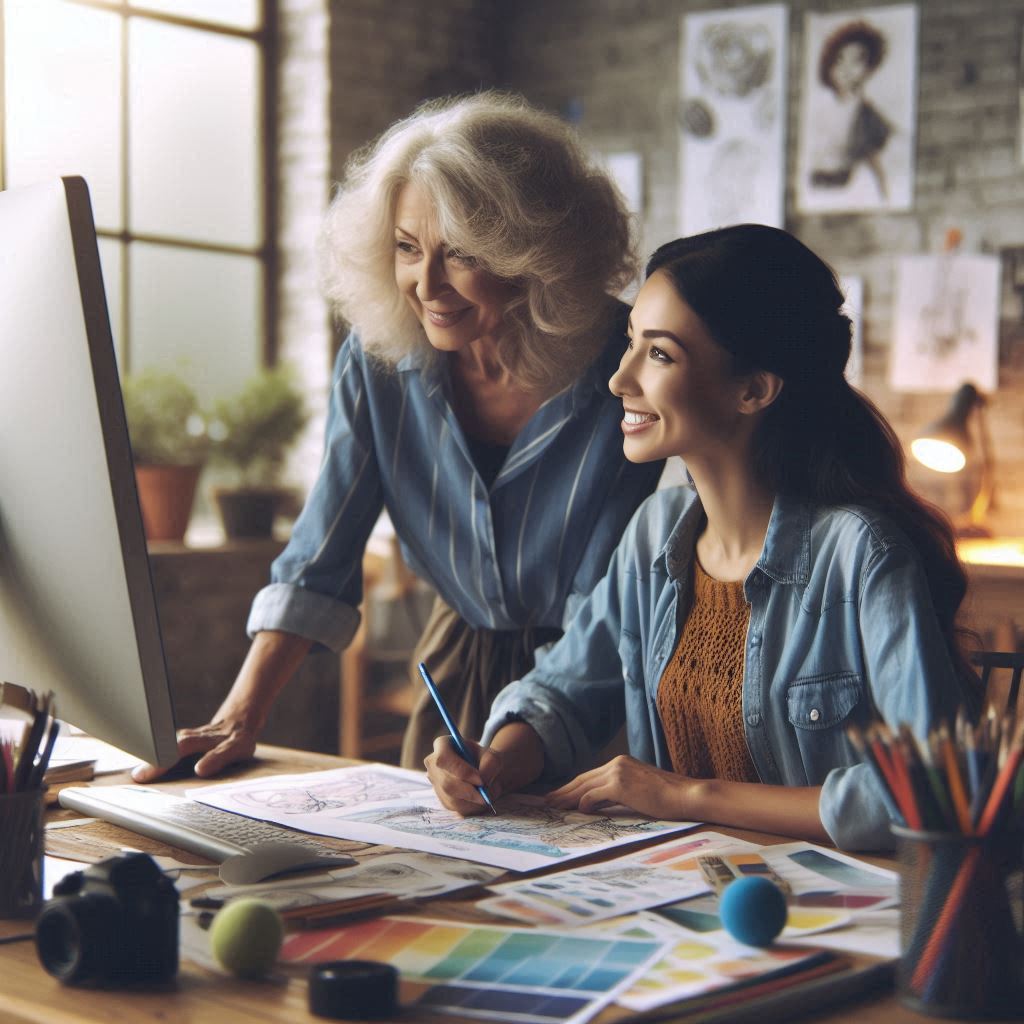Introduction
Exploring different illustration styles and techniques is a crucial step for any artist or designer aiming to expand their creative potential.
Each style brings a unique approach to visual storytelling, allowing illustrators to communicate ideas, emotions, and messages in diverse ways.
From traditional methods like pencil sketches and watercolors to modern digital techniques, understanding the breadth of illustration styles enables artists to push boundaries and experiment with their work.
For illustrators and designers, mastering a variety of styles is not just about personal growth‘it’s essential for adapting to client needs and industry trends.
Whether you‘re working on children’s books, advertisements, or editorial illustrations, having knowledge of different techniques helps you deliver work that resonates with a specific audience or purpose.
By becoming proficient in a range of styles, illustrators can enhance their versatility, appeal to a broader client base, and elevate the quality of their portfolio.
In this blog post, we will explore several popular illustration styles, including realism, abstract, minimalism, and more.
We’ll also delve into key techniques such as digital painting, vector illustration, watercolor, and collage, explaining how each can be applied to different projects.
Definition of Illustration Styles
The Concept of Illustration Styles and How They Vary
Illustration styles are more than just aesthetic choices; they define the tone and emotional impact of an artwork.
Styles reflect an artist’s personality, interests, and skill set.
An illustrator may choose a particular style based on the message they want to convey or the audience they intend to reach.
Some artists develop a signature style that distinguishes them from others, while others experiment with multiple styles depending on the project.
Artistic styles evolve over time, influenced by cultural trends, technology, and personal growth.
For example, an illustrator might begin with traditional techniques, later transitioning to digital formats.
With each evolution, their work gains new dimensions.
Ultimately, illustration styles are fluid, allowing artists the freedom to express themselves in unique and innovative ways.
Examples of Popular Illustration Styles
Several popular illustration styles dominate both traditional and digital art today.
Each style brings its own set of characteristics, appealing to different tastes and audiences.
Realism
Realism aims to depict subjects as they appear in the natural world.
Realistic illustrations often feature meticulous attention to detail, emphasizing accurate anatomy, lighting, and textures.
This style is commonly used in portraiture, editorial illustrations, and product design.
Abstract
Abstract illustration rejects realistic representation in favor of shapes, colors, and forms that evoke emotion rather than depict reality.
Artists working in this style prioritize creative freedom, using vibrant colors and unconventional compositions to communicate complex ideas.
Abstract illustrations often convey mood and symbolism.
Cartoon
Cartoon-style illustrations are characterized by exaggerated features, simplified forms, and playful aesthetics.
This style is popular in children’s books, comic strips, and animation.
Cartoon illustrations often highlight humor, making them ideal for storytelling that appeals to younger audiences or lighthearted themes.
Manga
Originating in Japan, manga is a popular style recognized for its distinctive characters, expressive faces, and dynamic action sequences.
Manga illustrations often incorporate detailed backgrounds and cinematic framing, creating a vivid, immersive experience for readers.
This style thrives in comics and graphic novels, particularly in the fantasy and adventure genres.
How Each Style Evokes Different Emotions and Messages
Each illustration style elicits different emotions and reactions from the audience.
Realism often conveys a sense of seriousness and depth, making it ideal for work that requires accuracy and detail.
Abstract styles can evoke a wide range of emotions, from confusion to awe, by leaving interpretation open to the viewer.
Cartoons, with their playful and exaggerated forms, typically create feelings of joy, humor, or innocence.
Manga-style illustrations draw in audiences with their emotional intensity, often creating suspense, excitement, or empathy.
Therefore, choosing an illustration style allows artists to shape the narrative and emotional impact of their work.
Whether an illustrator gravitates toward realism, abstract, cartoon, or manga, the chosen style defines the viewer‘s experience.
Each approach is a tool for expressing creativity and connecting with the audience on a deeper level.
Read: Breaking Down Iconic Movie Costumes
Traditional vs. Digital Techniques
Compare and Contrast Traditional Illustration Techniques with Digital Illustration Techniques
Traditional illustration techniques involve using physical tools and materials.
Artists typically use pencils for sketches, pens for inking, and paints for color.
These methods allow for texture and depth that many artists find appealing.
Traditional mediums often produce unique, organic results.
On the other hand, digital illustration techniques utilize software and tablets for creating art.
Programs like Adobe Illustrator and Procreate offer vast options for artists.
Digital tools enable infinite color palettes and undo functions, which enhance flexibility during the creative process.
Artists who prefer traditional methods appreciate the tactile experience of working with physical materials.
However, digital tools provide more efficiency and convenience.
For instance, digital illustrations can be easily edited and shared online.
This accessibility appeals to many modern artists, especially those looking to reach broader audiences.
Advantages and Disadvantages of Each Technique in Terms of Creativity, Efficiency, and Ease of Use
Each illustration technique has its advantages and disadvantages.
Traditional techniques promote creativity through physical interaction with materials.
Artists often experiment with textures and techniques, leading to unique styles.
However, traditional methods can be time-consuming and require extensive practice.
Conversely, digital illustration offers enhanced efficiency.
Artists can quickly make adjustments, explore various styles, and save time on revisions.
Programs like Procreate provide intuitive interfaces that streamline the creative process.
However, digital tools may sometimes limit creativity, as artists rely on pre-set brushes and effects.
Ease of use varies between the two methods.
Beginners might find digital tools more accessible due to online tutorials.
Yet, mastering software can be challenging and may require practice.
Traditional techniques often demand significant time investment to develop skills, but they can be gratifying.
How Artists Can Combine Traditional and Digital Techniques to Create Unique Illustrations
Many artists find success by blending traditional and digital techniques.
This combination allows them to harness the strengths of both methods.
For instance, artists can create initial sketches using pencil and then scan them into digital software.
From there, they can refine and color their work using programs like Adobe Illustrator.
This hybrid approach provides flexibility and encourages experimentation.
Artists can achieve unique textures with traditional tools while utilizing the efficiency of digital editing.
By integrating both methods, illustrators can develop distinctive styles that showcase their creativity.
Basically, exploring different illustration styles and techniques can enrich an artist’s practice.
Traditional and digital methods each offer unique advantages and challenges.
By understanding these differences, artists can make informed choices.
Combining both techniques leads to innovative illustrations that stand out in the creative landscape.
Read: Freelance vs. In-House Costume Design Jobs
Exploring Different Cultural Influences
How Cultural Influences Can Shape an Artist’s Illustration Style
Cultural influences play a significant role in shaping an artist’s illustration style.
Artists often draw inspiration from their backgrounds and experiences.
For example, traditional patterns, colors, and themes from specific cultures can inform an artist’s unique aesthetic.
Cultural narratives also inform the stories artists choose to illustrate.
An artist‘s upbringing in a particular culture can deeply influence their subject matter.
For instance, folklore, mythology, and history can inspire distinct visual elements in their work.
By examining these influences, artists can develop a style that reflects their identity and cultural heritage.
This connection to culture adds depth to their illustrations, making them more relatable and meaningful.
How Artists Can Incorporate Elements from Different Cultures into Their Work to Create Diverse and Inclusive Illustrations
Incorporating elements from various cultures can enrich an artist’s illustrations.
Artists can research different cultural practices, symbols, and narratives to gain inspiration.
This research allows them to explore new perspectives and themes in their work.
When integrating cultural elements, artists should approach the process respectfully.
Understanding the context and significance of these elements is crucial.
This awareness helps prevent cultural appropriation and promotes genuine representation.
By mixing techniques and styles from different cultures, artists can create diverse illustrations.
For instance, they might blend traditional Japanese ink techniques with contemporary digital styles.
This fusion results in fresh, innovative artwork that appeals to a broader audience.
Examples of Famous Artists Who Have Drawn Inspiration from Various Cultures in Their Illustrations
Many renowned artists draw inspiration from various cultures in their work.
One such artist is Jean-Michel Basquiat.
He fused African, Caribbean, and American influences in his graffiti-inspired art.
His unique style combined text and imagery, creating powerful social commentary.
Another example is Frida Kahlo, who incorporated Mexican culture into her art.
Her use of vibrant colors and traditional symbols celebrates her heritage.
Kahlo‘s work reflects her personal experiences while embracing her cultural roots.
Yayoi Kusama is another prominent artist known for her use of polka dots and vibrant patterns.
Her art reflects influences from her Japanese background and Western pop culture.
Kusama‘s distinctive style has made her a global icon in contemporary art.
By examining these artists, aspiring illustrators can see the impact of cultural influences on their work.
They demonstrate how blending diverse elements can create rich, meaningful illustrations.
In review, exploring different illustration styles and techniques requires an understanding of cultural influences.
Artists can enhance their work by incorporating elements from various cultures.
This approach fosters diversity and inclusivity in the art world, enriching the artistic landscape for all.
By following the examples set by famous artists, illustrators can create unique, culturally inspired works that resonate with a wider audience.
Read: Networking Events for Costume Designers
Experimenting with Mixed Media
The Concept of Mixed Media
Mixed media refers to using multiple materials in a single artwork.
Artists can combine traditional mediums like watercolor, ink, or acrylics with unconventional materials like fabric, paper, and found objects.
This approach results in rich textures, vibrant colors, and unique visual effects.
By blending different techniques, illustrators can convey depth and emotion in their work.
Mixed media encourages creativity and innovation.
Artists can break free from conventional boundaries and explore new ways to express ideas.
This style invites experimentation, allowing artists to discover unexpected combinations that enhance their illustrations.
Overall, mixed media opens up endless possibilities for creativity in the illustration world.
Tips for Experimenting with Different Mediums
To start experimenting with mixed media, artists can follow some simple tips.
First, gather various materials such as collage papers, fabric scraps, and digital overlays.
Consider using everyday items like old magazines, newspapers, or textiles.
These materials can add depth and interest to your illustrations.
Next, start layering.
Apply a base layer using paint or pencil, then add collage elements to create texture.
Fabric can be used to introduce softness or unique patterns.
Digital overlays can enhance traditional illustrations, providing a contemporary twist.
Experiment with different combinations to see what resonates with your artistic vision.
Additionally, don‘t be afraid to make mistakes.
Mixed media thrives on experimentation.
Embrace the process and allow your work to evolve organically.
You might discover unexpected results that enhance your artistic style.
Take the time to practice and refine your techniques, and you’ll develop a personal mixed media style.
Examples of Mixed Media Illustrations
Many established and emerging artists excel in mixed media illustrations.
Renowned artist Kiki Smith combines traditional techniques with found objects to create captivating narratives.
Her work often features intricate layers that tell a story, inviting viewers to engage with each detail.
Emerging artist Sarah McMenemy showcases vibrant mixed media illustrations that blend paper collage with digital elements.
Her colorful compositions demonstrate how diverse materials can come together harmoniously.
McMenemy‘s work highlights the versatility of mixed media and its potential for storytelling.
Another inspiring example is the work of artist Chris Sickels.
He creates whimsical three-dimensional illustrations using fabric, paper, and various found objects.
Sickels’ unique approach demonstrates how mixed media can create immersive experiences for viewers.
Generally, mixed media opens up a world of possibilities for illustrators.
By combining different materials and techniques, artists can create visually stunning works that captivate and inspire.
Experimenting with various mediums encourages creativity and fosters personal artistic growth.
As illustrated by the works of established and emerging artists, the potential of mixed media is truly limitless.
So, gather your materials, unleash your creativity, and dive into the exciting world of mixed media illustration!
Transform Your Career Today
Unlock a personalized career strategy that drives real results. Get tailored advice and a roadmap designed just for you.
Start NowRead: Building a Portfolio for Costume Design

Understanding the Role of Color and Composition
Importance of Color Theory and Composition in Creating Visually Appealing Illustrations
Color theory provides the foundation for selecting and combining colors in illustrations.
It helps artists understand how colors interact and influence one another.
Understanding concepts such as complementary, analogous, and triadic color schemes can enhance visual appeal.
A well-thought-out color palette can create harmony and balance within an illustration.
Composition, on the other hand, involves arranging elements within the artwork.
Good composition guides the viewer‘s eye and emphasizes key focal points.
Utilizing techniques such as the rule of thirds and leading lines can create more dynamic and engaging illustrations.
Together, color theory and composition work hand in hand to elevate the overall impact of the artwork.
Tips on How to Use Color Palettes Effectively and How to Create Balanced Compositions
To use color palettes effectively, start by selecting a limited number of colors.
This approach helps maintain visual cohesion and prevents overwhelming the viewer.
Create a mood board with your chosen colors to visualize how they interact.
Experiment with various combinations to find what resonates with your style.
When it comes to composition, aim for balance and harmony.
Symmetrical compositions create stability, while asymmetrical arrangements add interest.
Use negative space strategically to give your elements room to breathe.
This space prevents clutter and directs focus to essential components.
Consider the flow of the illustration and ensure elements lead the viewer‘s eye through the piece.
How Artists Can Use Color and Composition to Convey Emotions and Enhance Storytelling in Their Illustrations
Color and composition are powerful tools for conveying emotions in illustrations.
Warm colors, like reds and yellows, evoke feelings of excitement or warmth.
Cool colors, such as blues and greens, often elicit calmness or sadness.
By thoughtfully choosing colors, artists can enhance the emotional impact of their work.
Composition also plays a vital role in storytelling.
The placement of characters, objects, and backgrounds can influence the narrative.
For instance, positioning a character in the foreground can create intimacy, while placing them in the background can suggest distance or isolation.
Use angles and perspectives to create tension or drama within the scene.
In general, understanding color theory and composition is crucial for aspiring illustrators.
These elements enhance the visual appeal of your work and deepen the emotional connection with viewers.
By effectively using color palettes and creating balanced compositions, artists can elevate their illustrations.
Ultimately, mastering these techniques allows illustrators to convey powerful stories and evoke emotions through their art.
Embracing Different Art Movements
How Artists Can Draw Inspiration from Different Art Movements
Many artists find inspiration in historical art movements.
Surrealism, for example, offers a dream-like quality that challenges reality.
Artists can experiment with unexpected juxtapositions and imaginative landscapes, leading to striking illustrations.
Pop art, characterized by bright colors and bold imagery, celebrates consumer culture.
Artists can draw from this movement by incorporating iconic symbols and mass media elements into their work.
This approach allows for vibrant illustrations that engage viewers on multiple levels.
Minimalism emphasizes simplicity and essential forms.
Artists can benefit from this movement by stripping away unnecessary details.
This technique focuses on clarity and precision, helping to convey powerful messages in a straightforward manner.
How Incorporating Elements from Art Movements Can Help Artists Develop Their Unique Illustration Style
Incorporating elements from various art movements can significantly influence an artist’s style.
By blending techniques, artists can discover new ways to express themselves.
For instance, an artist might combine surrealist dreamscapes with minimalist designs to create captivating pieces.
This hybrid approach fosters creativity and encourages innovation.
Artists can experiment with color palettes, line work, and composition inspired by different movements.
This exploration leads to a distinctive style that reflects personal vision while drawing from established art forms.
Moreover, referencing historical movements can deepen an artist’s understanding of visual language.
It enriches their artistic vocabulary and enhances their ability to convey emotions and concepts.
As a result, artists can connect with their audience on a more profound level.
Examples of Illustrations Influenced by Specific Art Movements and Their Impact on the Art World
Many contemporary illustrators draw from various art movements, creating impactful works.
For example, artist Yayoi Kusama‘s illustrations reflect elements of surrealism and pop art.
Her bold colors and repetitive patterns captivate viewers while challenging perceptions of reality.
Another example is the work of illustrator Malika Favre, who incorporates minimalist techniques with pop art influences.
Her clean lines and striking color contrasts create a sense of elegance and sophistication.
These illustrations showcase how combining styles can produce stunning results.
Additionally, the graphic novel “Saga” by Fiona Staples merges elements of sci-fi and surrealism.
This innovative blend captivates readers and expands the boundaries of traditional comic illustration.
In essence, exploring different art movements can inspire illustrators to develop their unique styles.
By drawing from surrealism, pop art, and minimalism, artists can create compelling works.
Incorporating these influences not only enhances individual expression but also enriches the art world as a whole.
Ultimately, the fusion of styles leads to creativity, innovation, and a deeper connection with audiences.
Discover More: Day in the Life of a Creative Director
Collaborating with Other Artists
The Benefits of Collaborating with Other Artists
Collaboration fosters a rich exchange of knowledge and skills among artists.
When artists work together, they share diverse techniques and perspectives.
This exchange can lead to innovative ideas and approaches that might not arise in isolation.
Learning from fellow artists helps break creative blocks.
A fresh perspective can inspire new concepts and techniques.
Collaboration encourages experimentation, leading to a more dynamic and versatile artistic practice.
Embracing this opportunity allows artists to step outside their comfort zones and explore new styles.
Participating in Group Projects, Workshops, and Online Communities
Participating in group projects and workshops is a fantastic way for artists to expand their skills.
These settings encourage collaboration and interaction among peers.
Artists can learn new techniques through hands-on experiences, guided by more experienced professionals.
Online communities provide a platform for artists to connect with others globally.
Websites like Behance and DeviantArt allow artists to showcase their work and receive feedback.
Engaging with these communities can spark inspiration and foster relationships with fellow creatives.
Joining challenges or themed collaborations in these online spaces helps artists push their boundaries.
For example, participating in monthly illustration prompts encourages creativity and consistency.
Artists can experiment with different styles while receiving constructive criticism from peers.
Success Stories of Collaborative Artists
Many successful artists attribute their growth to collaboration with others.
For instance, the renowned duo Hattie Stewart and Craig & Karl have made waves in the illustration world.
Their collaborative projects blend their unique styles, creating vibrant and eye-catching artwork.
Another inspiring example is the partnership between illustrators Lisa Congdon and Ellen Weinstein.
They collaborated on a project that combined their distinct styles, resulting in innovative and engaging illustrations.
Their work showcases the beauty of collaboration, demonstrating how artists can enhance their creativity together.
Furthermore, the collective “The Drawn Together Project” brought together multiple artists to create a book.
This initiative highlights how collaboration can yield exceptional results while showcasing diverse styles.
The final product became a testament to the power of teamwork and creativity.
Ultimately, collaborating with other artists offers numerous benefits for exploring different illustration styles and techniques.
By participating in group projects, workshops, and online communities, artists can expand their creative skills.
Success stories of collaborative artists illustrate the potential for innovation and inspiration through teamwork.
Embracing collaboration can lead to a more fulfilling and dynamic artistic journey.
Conclusion
In this blog, we covered a variety of illustration styles and techniques, each offering unique characteristics and creative potential.
We highlighted traditional hand-drawn techniques, including pencil sketches and ink drawings, as well as modern digital art forms, such as vector illustrations and digital painting.
Exploring different styles opens up new ways to express creativity, convey emotions, and visually tell stories.
Understanding and experimenting with different techniques can significantly elevate your illustration skills.
Whether you’re working with minimalist line art, bold graphic design, or intricate watercolor painting, each approach teaches you something new.
By experimenting with various styles, you not only develop versatility but also gain insights into what resonates with your artistic voice.
Collaborating with other illustrators can also expose you to fresh ideas and new methods, enhancing your creative repertoire.
I encourage you to embrace experimentation and explore unfamiliar styles, techniques, and mediums to grow as an illustrator.
Pushing your creative boundaries helps refine your artistic identity and produce more dynamic, engaging work.
Don‘t be afraid to step outside your comfort zone and challenge yourself with new methods of illustration.
[E-Books for Sale]
The Big Book of 500 High-Paying Jobs in America: Unlock Your Earning Potential
$19.99 • 500 High-Paying Jobs • 330 pages
Explore 500 high-paying jobs in America and learn how to boost your career, earn more, and achieve success!
See All 500 High-Paying Jobs of this E-Book
1001 Professions Without a Degree: High-Paying American Jobs You Can Start Now
$19.99 • 1001 Professions Without a Degree • 174 pages
Discover 1001 high-paying jobs without a degree! Unlock career tips, skills, and success strategies for just $19.99!




